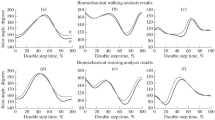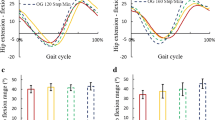Abstract
One countermeasure used during long-duration spaceflight to maintain bone and muscle mass is a treadmill equipped with a subject loading system (SLS) that simulates gravity. To date, little is known about the biomechanics of running in weightlessness on such a treadmill-SLS system. We have designed an instrumented treadmill/force plate to compare the biomechanics of running in weightlessness to running on Earth. Gravity was simulated by two pneumatic pistons pulling downward on a subject’s harness, with a force approximately equal to body weight on Earth. Four transducers, mounted under the treadmill, measured the three components of the reaction force exerted by the tread belt under the foot. A high-speed video camera recorded the movements of limb segments while the electromyography of the four lower limb muscles was registered. Experiments in weightlessness were conducted during the European Space Agency parabolic flight campaigns. Control experiments were performed on the same subjects on Earth. When running on the treadmill with an SLS, the bouncing mechanism of running is preserved. Depending on the speed of progression, the ground reaction forces, contact and aerial times, muscular work and bone stress differed by a maximum of ±5–15% during running on the treadmill with an SLS, as compared to that on Earth. The movements of the lower limb segments and the EMG patterns of the lower limb muscles were also comparable. Thus, the biomechanics of running on Earth can reasonably be duplicated in weightlessness using a treadmill with an SLS that generates a pull-down force close to body weight on Earth.













Similar content being viewed by others
References
Augurelle AS, Penta M, White O, Thonnard JL (2003) The effects of a change in gravity on the dynamics of prehension. Exp Brain Res 148:533–540
Cappellini G, Ivanenko YP, Poppele RE, Lacquaniti F (2006) Motor patterns in human walking and running. J Neurophysiol 95:3426–3437
Cavagna GA (1975) Force platforms as ergometers. J Appl Physiol 39:174–179
Cavagna GA, Saibene FP, Margaria R (1963) External work in walking. J Appl Physiol 18:1–9
Cavagna GA, Thys H, Zamboni A (1976) The sources of external work in level walking and running. J Physiol (London) 262:639–657
Cavagna GA, Franzetti P, Heglund NC, Willems P (1988) The determinants of the step frequency in running, trotting and hopping in man and other vertebrates. J Physiol (London) 399:81–92
Cavagna GA, Willems PA, Franzetti P, Detrembleur C (1991) The two power limits conditioning step frequency in human running. J Physiol (London) 437:95–108
Cavanagh PR, Davis BL, Miller TA (1992) A biomechanical perspective on exercise countermeasures for long term spaceflight. Aviat Space Environ Med 63:482–485
Collet P, Uebelhart D, Vico L, Moro L, Hartmann D, Roth M, Alexandre C (1997) Effects of 1- and 6-month spaceflight on bone mass and biochemistry in two humans. Bone 20:547–551
Davis BL, Cavanagh PR, Bock RG, Sommer J (1992) Ground reaction forces in zero-gravity locomotion simulator. Abstract. J Biomech 25:762
Dempster WT, Gaughran GRL (1967) Properties of body segments based on size and weight. Am J Anat 120:33–54
Elftman H (1939) Forces and energy changes in the limb segments. Am J Physiol 125:339–356
Frost HM, Ferretti JL, Jee WS (1998) Perspectives: some roles of mechanical usage, muscle strength, and the mechanostat in skeletal physiology, disease, and research. Calcif Tissue Int 62:1–7
Gosseye TP, Willems PA, Heglund NC (2005) Design of an active gravity simulator. Comput Methods Biomech Biomed Eng 8(S1):121–122
Heglund NC (1981) A simple design for a force-plate to measure ground reaction forces. J Exp Biol 93:333–338
Kram R, Griffin TM, Donelan JM, Chang YH (1998) Force treadmill for measuring vertical and horizontal ground reaction forces. J Appl Physiol 85:764–769
Lambertz D, Pérot C, Kaspranski R, Goubel F (2001) Effects of long-term spaceflight on mechanical properties of muscles in humans. J Appl Physiol 90:179–188
Lang T, LeBlanc A, Evans H, Lu Y, Genant H, Yu A (2004) Cortical and trabecular bone mineral loss from the spine and hip in long-duration spaceflight. J Bone Miner Res 19:1006–1012
LeBlanc A, Lin C, Shackelford L, Sinitsyn V, Evans H, Belichenko O, Schenkman B, Kozlovskaya I, Oganov V, Bakulin A, Hedrick T, Feeback D (2000) Muscle volume, MRI relaxation times (T2), and body composition after spaceflight. J Appl Physiol 89:2158–2164
McCrory JL, Baron HA, Balkin S, Cavanagh PR (2002) Locomotion in simulated microgravity: gravity replacement loads. Aviat Space Environ Med 73:625–631
Minetti AE, Ardigò LP, Saibene F (1994) Mechanical determinants of the minimum energy cost of gradient running in humans. J Exp Biol 195:211–225
Mochon S, McMahon TA (1980) Ballistic walking. J Biomech 13:49–57
Mosley JR, Lanyon LE (1998) Strain rate as a controlling influence on adaptive modeling in response to dynamic loading of the ulna in growing male rats. Bone 23:313–318
Novacheck TF (1998) The biomechanics of running. Gait Posture 7:77–95
O’Connor JA, Lanyon LE, MacFie H (1982) The influence of strain rate on adaptive bone remodelling. J Biomech 15:767–781
Pavy-Le Traon A, Heer M, Narici MV, Rittweger J, Vernikos J (2007) From space to Earth: advances in human physiology from 20 years of bed rest studies (1986–2006). Eur J Appl Physiol 101:143–194
Rubin C, Gross T, Qin YX, Fritton S, Guilak F, McLeod K (1996) Differentiation of the bone-tissue remodeling response to axial and torsional loading in the turkey ulna. J Bone Joint Surg Am 78:1523–1533
Sasimontonkul S, Bay BK, Pavol MJ (2007) Bone contact forces on the distal tibia during the stance phase of running. J Biomech 40:3503–3509
Schaffner G, DeWitt J, Bentley J, Yarmanova E, Kozlovskaya I, Hagan D (2005) Effect of load levels of subject loading device on gait, ground reaction force, and kinematics during human treadmill locomotion in a weightless environment. National Aeronautics and Space Administration NASA/TP-2005-213169
Sibonga JD, Evans HJ, Sung HG, Spector ER, Lang TF, Oganov VS, Bakulin AV, Shackelford LC, LeBlanc AD (2007) Recovery of spaceflight-induced bone loss: bone mineral density after long-duration missions as fitted with an exponential function. Bone 41:973–978
Turner RT (2000) Invited review: what do we know about the effects of spaceflight on bone? J Appl Physiol 89:840–847
West JB (2000) Physiology in microgravity. J Appl Physiol 89:379–384
Willems PA, Cavagna GA, Heglund NC (1995) External, internal and total work in human locomotion. J Exp Biol 198:379–393
Williams KR (1985) A comparison of 2-D versus 3-D analyses of distance running kinematics. In: Winter D, Norman R, Wells R, Hayes K, Patla A (eds) Biomechanics, IX-B, vol 5B. Human Kinetics Publishers, Inc., Champaign, pp 331–336
Winter DA (1991) The biomechanics of motor control and human gait: normal, elderly and pathological. University of Waterloo Press, Ontario, Epub 2002 Nov 15
Winter DA, Sidwall HG, Hobson DA (1974) Measurement and reduction of noise in kinematics of locomotion. J Biomech 7:157–159
Acknowledgments
This study was supported by an ESA/PRODEX/BELSPO funding (Contract No. C15379).
Author information
Authors and Affiliations
Corresponding author
Additional information
Communicated by Jean-René Lacour.
Rights and permissions
About this article
Cite this article
Gosseye, T.P., Willems, P.A. & Heglund, N.C. Biomechanical analysis of running in weightlessness on a treadmill equipped with a subject loading system. Eur J Appl Physiol 110, 709–728 (2010). https://doi.org/10.1007/s00421-010-1549-9
Accepted:
Published:
Issue Date:
DOI: https://doi.org/10.1007/s00421-010-1549-9




